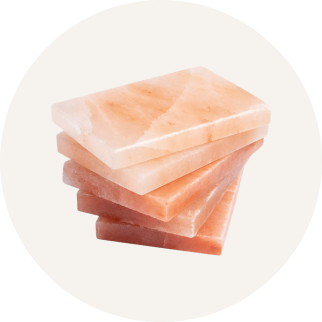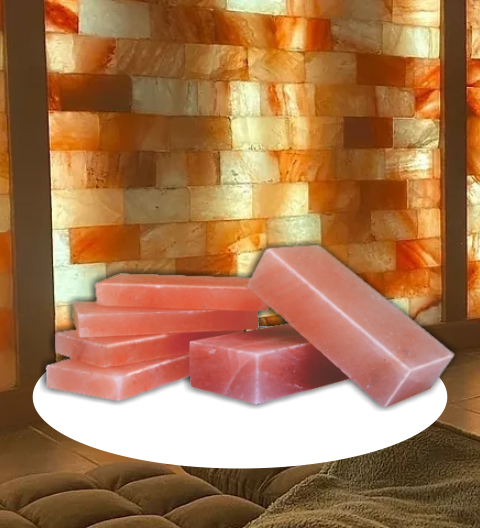The use of Himalayan Salt blocks has become popular not only as an uncommon cooking utensil but also due to their possible positive effects on health, such as their influence on melatonin production. Melatonin, also known as the "sleep hormone," is essential in controlling sleeping patterns and enhancing general health. This writing will examine the potential advantages of Himalayan salt blocks in enhancing melatonin hormone production and promoting improved sleep.
Understanding Melatonin
The brain's pineal gland produces melatonin, a hormone, and the circadian rhythm, which is the body's internal clock, influences it. The intricate connection between this rhythm and darkness and light is evident. As the night approaches and darkness sets in, melatonin levels usually increase, signaling the body to ready itself for slumber.
Various factors can disrupt the average production of melatonin, such as exposure to artificial light, mainly blue light from electronic devices, inconsistent sleep schedules, and stress. The disturbances may result in challenges in initiating or maintaining sleep, which can cause several health problems like sleep disorders and insomnia.
The Himalayan Salt Block's Function
Salt blocks from the Himalayas, recognized for their distinct pink color, are abundant in trace elements and minerals like magnesium, calcium, and potassium. Their exceptional composition has made them popular for serving, cooking, and therapeutic purposes. Although the primary objective of utilizing Himalayan Salt blocks in the culinary industry is to amplify the taste of the cuisine, a few devotees contend that they could offer supplementary health advantages.

Improving Air Quality through Ionization
Himalayan Salt blocks can affect melatonin levels by ionizing the air. This theory suggests that when heated, salt releases negative ions that have several beneficial effects on the body, such as enhancing mood and decreasing stress.
Heated Himalayan Salt blocks emit negative ions that can produce a more serene and harmonious ambiance, which may improve sleep quality. By reducing stress and inducing relaxation, these negative ions could facilitate the production of melatonin, a hormone essential for regulating sleep. Anxiety and stress can disrupt the natural release of sleep hormones, but a more tranquil environment may help counteract these effects.
Mineral Absorption
The Himalayan Salt contains minerals necessary for numerous bodily processes, such as hormone production. Among these minerals, magnesium is especially significant as it aids in the transformation of tryptophan into serotonin and melatonin. Tryptophan is an amino acid that is a forerunner to these vital neurotransmitters.
Supporters claim that although the quantity of magnesium released from a salt block while cooking might not be significant, even small traces could still add to the overall magnesium consumption. Improved sleep quality is connected with sufficient magnesium levels, while insufficient levels of this mineral are associated with sleep disruptions.
Cooking Connection
In addition to possibly affecting melatonin levels, we mainly use Himalayan Salt blocks as a distinctive way to cook and serve food. Cooking on a salt block imparts a subtle but noticeable taste to the food, and we can use the blocks for different cooking methods like grilling, chilling, or searing.
To cook on a Himalayan Salt block, heat it until it becomes hot. Once the block is hot, it will transfer its heat to the food on top, resulting in a distinctive cooking method. Some contend that this technique maintains the inherent tastes of the components while adding a subtle touch of saltiness.
Improving Taste and Nutritional Value
Incorporating Himalayan Salt blocks into cooking may indirectly impact one's overall health and wellness by influencing dietary decisions and nutrient consumption. Essential minerals, abundant in Himalayan Salt, are necessary for optimal health.
The integration of Himalayan salt blocks in cooking can inspire people to explore a wider variety of whole, fresh foods, resulting in a more well-rounded and nutrient-rich diet, which can indirectly promote overall health, such as better sleep.
Considerations and Caveats
Although the possible advantages of Himalayan Salt blocks for melatonin and general well-being are fascinating, it is necessary to approach these statements skeptically. The scientific proof that backs up these claims is limited, and further research is essential to confirm a clear correlation between the use of salt blocks and enhanced melatonin production.
Furthermore, the impact of environmental factors on an individual, such as dietary minerals or negative ions, can differ significantly. What may be effective for someone may produce a different outcome for another. Therefore, it is vital to consider these variables when exploring alternative methods for enhancing sleep and overall health.
Use the Salt Blocks for the Himalayan Salt Wall
A Himalayan salt wall typically refers to a wall made from large chunks or blocks of Himalayan salt. Himalayan salt is a type of rock salt mined in the Himalayan region, primarily in Pakistan. It is known for its distinctive pink color, caused by trace minerals like iron and magnesium.

The concept of the Himalayan salt wall has gained popularity for aesthetic and potential health-related reasons. Some people believe these salt walls can positively affect air quality and well-being. When heated or exposed to moisture, the idea is that the salt releases negative ions that may help purify the air by neutralizing positive ions, which are often associated with pollutants and allergens.

Himalayan salt wall is often used in various settings, including homes, spas, yoga studios, and wellness centers. They can be incorporated as decorative elements or functional pieces. Some common uses include:
- Salt Lamps are smaller pieces of Himalayan salt often shaped into a lamp form with a light source inside. The heat from the bulb warms the salt, causing it to release negative ions and creating a soft, warm glow.
- Salt Walls: Larger blocks or panels of Himalayan salt can be assembled to create walls. These walls may be backlit to enhance their visual appeal and therapeutic potential.
- Salt Caves: Some wellness centers or spas create salt cave environments using Himalayan salt. The walls, ceilings, and floors are covered with salt, providing a unique and relaxing atmosphere.
While some people find Himalayan salt features aesthetically pleasing and potentially beneficial, it's important to note that scientific evidence supporting significant health benefits is limited. The impact of negative ions on human health is a topic of ongoing research, and individual experiences with salt-based products can vary.
Suppose you want to incorporate a Himalayan salt wall or other salt-related elements into your space. In that case, it's advisable to do so for their decorative appeal and potential relaxation benefits rather than relying on them as the sole solution for health concerns. Additionally, consult with professionals or experts in designing and implementing such features to ensure they are installed correctly and safely.
Conclusion
The culinary world can benefit from Himalayan Salt blocks, which add a distinctive and visually appealing touch and have potential health advantages, such as influencing melatonin production, as suggested by some enthusiasts. Although the science supporting these assertions is not entirely conclusive, there are credible ways in which salt blocks may indirectly improve sleep.
Like most holistic methods of promoting wellness, outcomes may differ for each person, and it’s necessary to view these techniques as supplementary rather than a conclusive answer. Including Himalayan salt blocks in your cooking routine can bring a sense of newness and inspire you to try various nutritious foods. These factors can positively affect your overall well-being, including improving your sleep.

